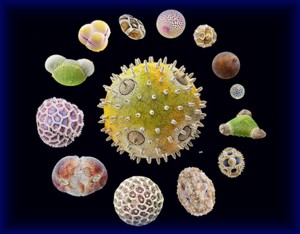|
Miracle powder
If the scientific establishment had a hall of fame, Nehemiah Grew would have to be counted among its most illustrious members. Vicar of St. Michaels, Coventry, for some years, his real interests and expertise lay in scientific endeavors, particularly in the fields of "vegetable anatomy" (botany) and physiology. Numbered among his many scientific works are titles such as " Seawater made Fresh, the Nature and Use of the Salt contained in Epsom and such other Waters", "The Anatomy of Vegetables Begun", and "Comparative Anatomy of Stomachs and Guts". He was the first person known to make a serious study of the ridges, grooves and pores of hands and feet and to publish drawings of fingerprint patterns. What he would be studying were he alive today is anybody's guess.
Grew was fortunate to have been born when he was - about fifty years after two Dutch spectacle makers, Zaccharias Janssen and his son, Hans, discovered that objects appeared greatly enlarged when viewed through several lenses in a tube, leading to the rapid evolution of the compound microscope. Of particular interest to us here was Grew's use of the new instrument in a study of pollen grains. Not only did he correctly hypothesize that the stamens found in flowers made up the male organs of flowering plants, he also made the breakthrough discovery that pollen grains produced by stamens from varying species of plant are remarkably different from each other in form; pollen from each species of plant has its own characteristic size, shape and surface ornamentation. (Later discoveries have shown that some species have more than one form of pollen, but that's another story.)
Grew realized that pollen is a topic worthy of serious study. Whether it inspired any of his sermons I don't know, but certainly his work inspired many others to take a close look at this living powder. What amazing, fascinating, "miraculous" stuff it is. Its high nutrition value makes it nature's "wholefood", constituting the staple diet of innumerable insect species. Its chief significance, however, lies in its role as the male agent of sexual reproduction among flowering plants. Its ability to fulfill its masculine purpose in life can be truly described as miraculous. Not only does pollen often survive amazingly hostile conditions - heat, cold, desiccation and even immersion in salt water in marine species - it has to know exactly what to do when it arrives at its destination. The "miraculousness", of course, is imparted to it by the genius of its design, each
|
kind being imbued with just the right biochemical makeup and anatomical structure to get safely from stamen to stigma and, once firmly fixed on female territory, to germinate and grow its tiny tube (pic top right) for transporting its genetic material to the female ovule buried deep within the stigma. And what brains the little motes must have; the tip of the growing pollen tube must succeed in finding the one cell among thousands that contains its sexual counterpart. Yes, it's a miracle!
In a word, rough enough is definitely not good enough when it comes to pollen. Perfection of design is paramount. Pollen that is carried from stamen to stigma by the good graces of breezes must first of all get "out there". In instances where breezes caress the pollen-producing stamen, mere release into the atmosphere is sufficient. But in cases, such as dense thickets, where the air movement is less reliable some mechanism is required to get the dust into the breeze. Some, such as stinging nettles and Japanese paper mulberry, use an explosive mechanism that shoots the pollen up into the air. Annual mercury has separate male and female flowers; "at the right moment, the male flowers are literally catapulted away in toto".1 Once in the air, success depends largely upon the ability to stay aloft and not sink to the ground. This need requires that the grains must be both very minute and very light and, above all, not sticky. Some wind-pollinated species actually have heavy pollen, but this heaviness is offset by the presence of air sacs! Design! Wisdom! Genius! Pollen that is carried to its destination by insects, by contrast, must either be sticky or have surface features that make it adhere to its host. More design, more ingenuity. Pollen of marine species of sea grasses has a shape and form that "together with the loss of the outer wall layer, make it possible for the pollen to be carried in water currents as long, rope-like masses". 2
Appropriately, the stunning beauty of many pollen grains matches their importance as agents of the perpetuation of vegetable life. If you haven't yet seen the photo gallery of pollen grains from the latest edition of National Geographic, then get cracking. These pictures cannot help but stir the spirit of those who love God. Pollen is beautiful not because the Big Bang vouchsafed it but because God crafted pollen to please our aesthetical senses and to demonstrate His infinite knack for creating artistic masterpieces.
|





